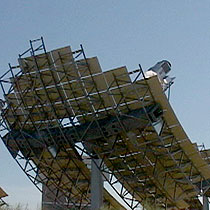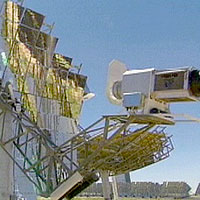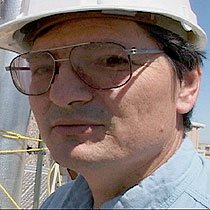2007年VOA标准英语-Sandia Laboratories Develops Promising Solar Te(在线收听)
Albuquerque, New Mexico
25 July 2007
As the world searches for ways to produce energy without burning fossil fuel, there is increased interest in solar energy. One place associated with solar power experiments is the Sandia National Laboratories near Albuquerque, New Mexico. VOA's Greg Flakus went there to prepare this report.

Large scale collection of solar power arrays
When many people think of solar energy they picture simple solar panels for heating water or photovoltaic cells that produce small amounts of electricity for a home.
But here at Sandia Labs, researchers look at big projects that are designed to replace large coal and natural gas electrical generating plants.
One of the most promising technologies is the parabolic solar collector that focuses the sun's rays to heat a gas. It is a simple engine developed nearly 200 years ago by an inventor in Scotland named Robert Stirling.
 |
| Bruce Osborn |
The heat that drives the engine comes from mirrors that concentrate the sun's energy on one point.
 |
| Mirror array controlled by computers |
Osborn's company already has two power plants operating in the southwestern United States, providing electricity generated by the sun. "These two projects are massive, about four billion kilowatt hours of electricity from these two projects, and it displaces more than four million tons of greenhouse gases."
Another promising solar technology is the parabolic trough. Here a large curved mirror concentrates the sun's energy on a tube, heating the oil inside it.
 |
| Tim Moss |
Researchers here discovered they could improve the efficiency of the device by carefully aligning its mirror to concentrate more heat on the tube.
Improved efficiency of solar devices makes them more competitive with traditional energy sources. Troughs are not as efficient as Stirling engines on parabolic solar collectors.
But Tim Moss says the trough has an important advantage. "Since we are using an oil, or fluid, per se, we can store the heat of that fluid overnight, so we can be generating electricity even when the sun is not shining."
While these technologies are already in use in some parts of the world, researchers here hope that improvements will expand the sun's role in creating a clean energy future.